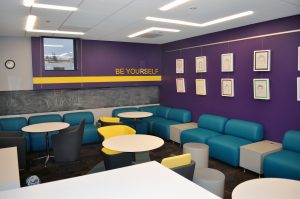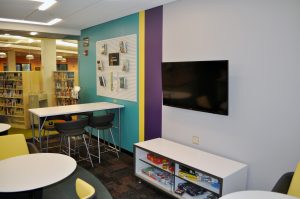Chalkboard Controversy: Naughty Graffiti and Social Media Safety in a Middle School Library Space
A chalkboard wall in a newly designed public library space for middle schoolers brought fun opportunities—and some unexpected challenges.

Image of "The Middle" space for tweens at the Glen Ellyn Public Library (IL), showing the chalkboard border on the far wall. Photo courtesy of Glen Ellyn Public Library.
Some background: our library considers students to be in the next grade level on the last day of school. As such, every summer is a bit of a transition period for us. Only kids in sixth through eighth grade are allowed to be in The Middle, and we sometimes have to go in and ask younger (and older) kids to leave. The transitional nature of summer always leaves us guessing. Sixth graders are at their shortest in the days right after finishing elementary school. We find ourselves not only questioning (or trusting) more kids but also getting comments from parents of older middle schoolers. Summer brings some seasonal users as well; kind of the opposite of snowbirds. We have a loyal group of regulars who only show up in the summer, then drop off the map during the school year. The start of summer also comes with some extra hype; kids come into the library specifically looking for The Middle, excited to experience their new library privilege. Unfortunately for us, the hype led to our first incidence of inappropriate behavior. A group of kids drew various pictures and cartoons featuring the male anatomy. Personally, I was surprised and admittedly naive. I caught the culprits, and they were told their parents would be notified if it happened again. I was naive to think their stunned looks and wide eyes was a cue that this was all over. It was not. Our graffiti artists continue to test our rules.
The opposite side of "The Middle" space. Photo courtesy of the Glen Ellyn Public Library.
Another unforeseen issue has sprung up around kids using the chalkboard to display personal information. Many kids leave social media handles and even their phone numbers on the board. These developments have brought up an internal debate over censorship vs. safety. There is a decal above the chalkboard that tells middle schoolers to “Be Yourself.” How far are we willing to let them go with this advice? Are we providing a welcoming environment if we clear the chalkboard after every time a student writes on it? I have always envisioned the wall becoming a community sounding board for middle schoolers. They want to provide kids with a safe place where they can express their individuality, but the chalkboard is easily viewable by any member of the public, making the display of personal information problematic. A lot is considered when we think about where middle school students and tweens belong in a public library. In some libraries, they get lumped into the YA section, whereas in others, they are considered part of the youth department. Some youth services departments include students up to 12thh grade, where others stop at sixth or eighth. Most, if not all, professionals agree that it is important for this group of library users to feel welcome and supported in the library environment, but the definition of expected behavior can change depending on the setting. There is generally a lower tolerance for violence and gratuitous romantic scenes in books and movies for this age group, and Internet browsing in youth departments are often more restricted (typically via filters). Library staff members walk a fine line between providing a safe space while not being directly responsible for a child. We can take this opportunity to inform our young users about Internet safety. Depending on what works in your community, this could be done in a variety of ways. You may want to host a class focusing on Internet safety, or work with your school librarian(s) and talk about it during a school visit. You can hold an orientation for the library tween space and include expectations of behavior, including how to keep your identity safe while using library services. Any of these options can be held as a lecture, lab, or in a classroom format. If you don’t think that an official program will garner attendance from a middle school audience, there’s always the one-on-one conversation option. This can be an excellent opportunity to build relationships with your middle grade library users; learning names and memorable facts about them to use as talking points during a return visit. There are many ways to inform, and all of these options can be beneficial for the middle schooler, and help strengthen your relationship with them. It is clear that library staff have to find the balance that makes all library users feel welcome in the space. No matter the issue, the benefits of providing a space for middle schoolers and tweens still outweighs the few hiccups that happen along the way. I feel lucky that I made it this long before our first issue. Making sure our young users are responsible and respectful of the library has always been part of my job, and while erasing graphic chalk drawings may be filed under “other duties as assigned,” seeing a middle schooler go into The Middle for the first time is more than I need to motivate me to continue.RELATED
RECOMMENDED
CAREERS
The job outlook in 2030: Librarians will be in demand
CAREERS
The job outlook in 2030: Librarians will be in demand
ALREADY A SUBSCRIBER? LOG IN
We are currently offering this content for free. Sign up now to activate your personal profile, where you can save articles for future viewing






Add Comment :-
Comment Policy:
Comment should not be empty !!!
Lucia V
My Teen Room (6-12th grade) has a large white board for the kids to use. Fromt he beginning, the rules I post on it have been "Keep it Clean & Nothing Mean." I ran into the same personal info sharing issue, as well, so i tagged on "And no sharing personal contact info!" When I catch them reading it, or discussing the rules, I use that time to explain that while this IS their space, it's part of a bigger public library, and anyone can come in off the street & see what they've written- "Even creepy people." I explain that leaving instagram handles or cell phone #s are not allowed up there because we can't be sure who is going to get that info, and we want them to be safe. Teens & tweens are not so great at recognizing that there are people around them outside of their usual bubble, or thinking through consequences, so while free expression is important, boundaries & heads-ups on unsafe/inappropriate behavior is an actual need for this group of patrons.Posted : Nov 18, 2017 12:26
Hilda
Not a fan of private spaces for kids in the age where schools are held very very very accountable for student's behavior. How do you know that kids are not being verbally abusive to each other in this type of space. Sorry, private space is at home.Posted : Nov 16, 2017 10:29